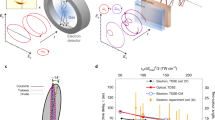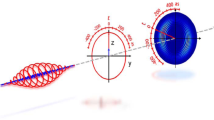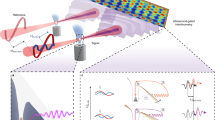Abstract
Laser-induced electron tunnelling—which triggers a broad range of ultrafast phenomena such as the generation of attosecond light pulses, photoelectron diffraction and holography—has laid the foundation for strong-field physics and attosecond science. Using the attoclock constructed by single-colour elliptically polarized laser fields, previous experiments have measured the tunnelling rates, exit positions, exit velocities and delay times for some specific electron trajectories, which are mostly created at the field peak instant, that is, when the laser electric field and the formed potential barrier are stationary in terms of the derivative versus time. From the view of wave-particle dualism, the electron phase under a classically forbidden, tunnelling barrier has not been measured, which is at the heart of quantum tunnelling physics. Here we present a robust measurement of tunnelling dynamics including the electron sub-barrier phase and amplitude. We combine the attoclock technique with two-colour phase-of-phase (POP) spectroscopy to accurately calibrate the angular streaking relation and to probe the non-stationary tunnelling dynamics by manipulating a rapidly changing potential barrier. This POP attoclock directly links the measured phase of the two-colour relative phase with the ionization instant for the photoelectron with any final momentum on the detector, allowing us to reconstruct the imaginary tunnelling time and the accumulated phase under the barrier. The POP attoclock provides a general time-resolved approach to accessing the underlying quantum dynamics in intense light–matter interactions.
This is a preview of subscription content, access via your institution
Access options
Access Nature and 54 other Nature Portfolio journals
Get Nature+, our best-value online-access subscription
$29.99 / 30 days
cancel any time
Subscribe to this journal
Receive 12 print issues and online access
$209.00 per year
only $17.42 per issue
Buy this article
- Purchase on Springer Link
- Instant access to full article PDF
Prices may be subject to local taxes which are calculated during checkout




Similar content being viewed by others
Data availability
The data that support the plots within this paper and other findings of this study are available from the corresponding author on reasonable request.
References
Corkum, P. B. & Krausz, F. Attosecond science. Nat. Phys. 3, 381–387 (2007).
Eckle, P. et al. Attosecond angular streaking. Nat. Phys. 4, 565–570 (2008).
Eckle, P. et al. Attosecond ionization and tunneling delay time measurements in helium. Science 322, 1525–1529 (2008).
Torlina, L. et al. Interpreting attoclock measurements of tunnelling times. Nat. Phys. 11, 503–508 (2015).
Sainadh, U. S. et al. Attosecond angular streaking and tunnelling time in atomic hydrogen. Nature 568, 75–77 (2019).
Camus, N. et al. Experimental evidence for quantum tunneling time. Phys. Rev. Lett. 119, 023201 (2017).
Ni, H., Saalmann, U. & Rost, J.-M. Tunneling ionization time resolved by backpropagation. Phys. Rev. Lett. 117, 023002 (2016).
Yakaboylu, E., Klaiber, M. & Hatsagortsyan, K. Z. Wigner time delay for tunneling ionization via the electron propagator. Phys. Rev. A 90, 012116 (2014).
Teeny, N., Yakaboylu, E., Bauke, H. & Keitel, C. H. Ionization time and exit momentum in strong-field tunnel ionization. Phys. Rev. Lett. 116, 063003 (2016).
Han, M. et al. Unifying tunneling pictures of strong-field ionization with an improved attoclock. Phys. Rev. Lett. 123, 073201 (2019).
Eicke, N., Brennecke, S. & Lein, M. Attosecond-scale streaking methods for strong-field ionization by tailored fields. Phys. Rev. Lett. 124, 43202 (2020).
Pedatzur, O. et al. Attosecond tunnelling interferometry. Nat. Phys. 11, 815–819 (2015).
Li, M. et al. Experimental verification of the nonadiabatic effect in strong-field ionization with elliptical polarization. Phys. Rev. A 95, 053425 (2017).
Eckart, S. et al. Direct experimental access to the nonadiabatic initial momentum offset upon tunnel ionization. Phys. Rev. Lett. 121, 163202 (2018).
Pfeiffer, A. N. et al. Attoclock reveals natural coordinates of the laser-induced tunnelling current flow in atoms. Nat. Phys. 8, 76–80 (2012).
Han, M. et al. Revealing the sub-barrier phase using a spatiotemporal interferometer with orthogonal two-color laser fields of comparable Intensity. Phys. Rev. Lett. 119, 073201 (2017).
Ni, H., Saalmann, U. & Rost, J.-M. Tunneling exit characteristics from classical backpropagation of an ionized electron wave packet. Phys. Rev. A 97, 013426 (2018).
Skruszewicz, S. et al. Two-color strong-field photoelectron spectroscopy and the phase of the phase. Phys. Rev. Lett. 115, 043001 (2015).
Almajid, M. A., Zabel, M., Skruszewicz, S., Tiggesbäumker, J. & Bauer, D. Two-color phase-of-the-phase spectroscopy in the multiphoton regime. J. Phys. B 50, 194001 (2017).
Tulsky, V. A., Almajid, M. A. & Bauer, D. Two-color phase-of-the-phase spectroscopy with circularly polarized laser pulses. Phys. Rev. A 98, 053433 (2018).
Würzler, D. et al. Accurate retrieval of ionization times by means of the phase-of-the-phase spectroscopy, and its limits. Phys. Rev. A 101, 033416 (2020).
Tulsky, V. A., Krebs, B., Tiggesbäumker, J. & Bauer, D. Revealing laser-coherent electron features using phase-of-the-phase spectroscopy. J. Phys. B 53, 074001 (2020).
Dörner, R. et al. Cold target recoil ion momentum spectroscopy: a ‘momentum microscope’ to view atomic collision dynamics. Phys. Rep. 330, 95–192 (2000).
Ullrich, J. et al. Recoil-ion and electron momentum spectroscopy: reaction-microscopes. Rep. Prog. Phys. 66, 1463–1545 (2003).
HuP, B., Liu, J. & Chen, S.-g Plateau in above-threshold-ionization spectra and chaotic behavior in rescattering processes. Phys. Lett. A 236, 533–542 (1997).
Li, M. et al. Subcycle dynamics of coulomb asymmetry in strong elliptical laser fields. Phys. Rev. Lett. 111, 023006 (2013).
Sun, X. et al. Calibration of the initial longitudinal momentum spread of tunneling ionization. Phys. Rev. A 89, 45402 (2014).
Milošević, D. B., Paulus, G. G., Bauer, D. & Becker, W. Above-threshold ionization by few-cycle pulses. J. Phys. B 39, R203–R262 (2006).
V Popruzhenko, S. Keldysh theory of strong field ionization: history, applications, difficulties and perspectives. J. Phys. B 47, 204001 (2014).
Geng, J.-W. et al. Nonadiabatic tunneling ionization of atoms in elliptically polarized laser fields. J. Phys. B 47, 204027 (2014).
Han, M., Li, M., Liu, M.-M. & Liu, Y. Tunneling wave packets of atoms from intense elliptically polarized fields in natural geometry. Phys. Rev. A 95, 023406 (2017).
Barth, I. & Smirnova, O. Nonadiabatic tunneling in circularly polarized laser fields: physical picture and calculations. Phys. Rev. A 84, (2011).
Eckart, S. et al. Ultrafast preparation and detection of ring currents in single atoms. Nat. Phys. 14, 701–704 (2018).
Popruzhenko, S. V. & Bauer, D. Strong field approximation for systems with Coulomb interaction. J. Mod. Opt. 55, 2573 (2008).
Yan, T.-M., Popruzhenko, S. V., Vrakking, M. J. J. & Bauer, D. Low-energy structures in strong field ionization revealed by quantum orbits. Phys. Rev. Lett. 105, 253002 (2010).
Huismans, Y. et al. Time-resolved holography with photoelectrons. Science 331, 61–64 (2011).
Mosert, V. & Bauer, D. Photoelectron spectra with qprop and t-surff. Comput. Phys. Commun. 207, 452–463 (2016).
Han, M., Ge, P., Shao, Y., Gong, Q. & Liu, Y. Attoclock photoelectron interferometry with two-color corotating circular fields to probe the phase and the amplitude of emitting wave packets. Phys. Rev. Lett. 120, 073202 (2018).
Ivanov, M. Y., Spanner, M. & Smirnova, O. Anatomy of strong field ionization. J. Modern Optics 52, 165–184 (2005).
Landau, L. D. & Lifschitz, E. M. Quantum Mechanics (Non-relativistic Theory) (Oxford Univ. Press, 1958).
Jordan, I. et al. Attosecond spectroscopy of liquid water. Science 369, 974–979 (2020).
Acknowledgements
Y.L. acknowledges the finance support by the National Science Foundation of China (grant nos. 92050201, 918850111 and 11774013). M.H. acknowledges funding from the European Union’s Horizon 2020 research and innovation programme under the Marie Skłodowska-Curie grant agreement no. 801459 (FP-RESOMUS) and the Swiss National Science Foundation through the NCCR MUST.
Author information
Authors and Affiliations
Contributions
M.H., P.G., and Z.G. performed the experiments. M.H., Y.F. and Y L. analysed and interpreted the data. Simulations were implemented by M. H. This project was coordinated by Y. L.. All authors discussed the results and wrote the paper.
Corresponding author
Ethics declarations
Competing interests
The authors declare no competing interests.
Additional information
Peer review information Nature Photonics thanks Karen Hatsagortsyan, Anatoli Kheifets and the other, anonymous, reviewer(s) for their contribution to the peer review of this work.
Publisher’s note Springer Nature remains neutral with regard to jurisdictional claims in published maps and institutional affiliations.
Supplementary information
Supplementary Information
Supplementary Figs. 1–6 and Discussion.
Supplementary Video 1
Animated measured angle-resolved energy spectrum in the POP attoclock.
Supplementary Video 2
Animated calculated angle-resolved energy spectrum in the POP attoclock using the CTMC model without including Coulomb potential.
Supplementary Video 3
Animated calculated angle-resolved energy spectrum in the POP attoclock using the CTMC model including Coulomb potential.
Supplementary Video 4
Animated calculated angle-resolved energy spectrum in the POP attoclock using the SFA model by numerical integration method.
Supplementary Video 5
Animated calculated angle-resolved energy spectrum in the POP attoclock using the CCSFA model.
Supplementary Video 6
Animated calculated angle-resolved energy spectrum in the POP attoclock using the TDSE method.
Rights and permissions
About this article
Cite this article
Han, M., Ge, P., Wang, J. et al. Complete characterization of sub-Coulomb-barrier tunnelling with phase-of-phase attoclock. Nat. Photon. 15, 765–771 (2021). https://doi.org/10.1038/s41566-021-00842-7
Received:
Accepted:
Published:
Issue Date:
DOI: https://doi.org/10.1038/s41566-021-00842-7
This article is cited by
-
Spatiotemporal imaging and shaping of electron wave functions using novel attoclock interferometry
Nature Communications (2024)
-
Full experimental determination of tunneling time with attosecond-scale streaking method
Light: Science & Applications (2022)
-
A look under the tunnelling barrier via attosecond-gated interferometry
Nature Photonics (2022)



